
The global pandemic of 2020 completely transformed the world of work for millions. Zoom meeting rooms, VPNs, and changing remote culture characterized by virtual teams became commonplace. But with these positive changes for employees came many organizational challenges.
The global pandemic forced companies to adapt to the hybrid workplace. Everything companies had learned about maintaining employee engagement and productivity became invalid as 1:1 communication became a thing of the past. Most organizations have adjusted, but many companies today are still catching up. Companies still develop hybrid work strategies to support employees working remotely to be the most productive and have the best well-being.
So what is a hybrid work strategy? What models can be used to develop a hybrid work strategy? And what challenges do you need to focus on to ensure that your design fits your company culture and is optimized to make it worth the investment? We will explore these questions, beginning with defining the hybrid work strategy.
What Is A Hybrid Work Strategy?
Hybrid working combines working in the office space and from home. The hybrid work strategy seeks to ensure the right balance of hybrid working for each employee to optimize their experience for themselves and their organization.
Organizations decide how to do this by collecting, visualizing, and reviewing data collected from employees about their experiences working from home and in office spaces. They use this information to choose appropriate hybrid models to formulate their hybrid work strategy that effectively supports their employees to achieve the best business outcomes.
How To Build A Hybrid Work Strategy
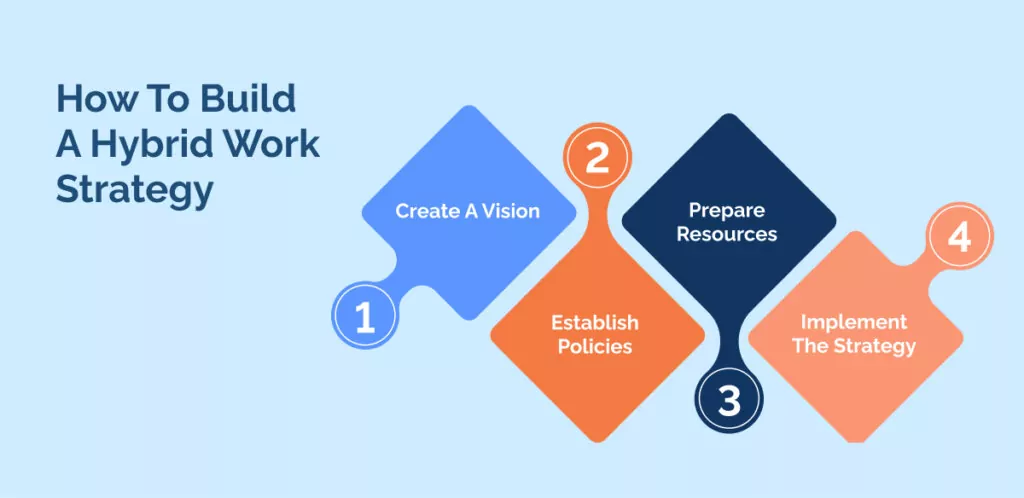
The first step is to develop and communicate a solid hybrid vision for the future of work within the company. With Microsoft reporting that 53% of workers now prioritize their health and well-being over work than they did before the global pandemic, companies need to build a transparent, robust, and supportive hybrid work strategy. This strategy will show existing employees and candidates for employment that an organization supports hybrid working.
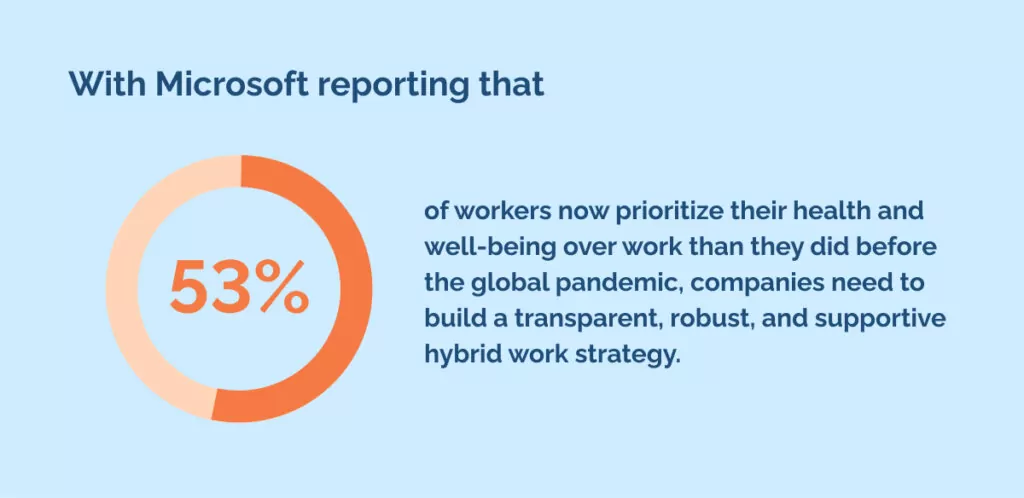
Create A Vision
Hybrid strategy leaders must establish their aims for what the hybrid workplace will achieve, define the details of the current workplace and create a set of workplace recommendations. The CEO must also ensure that the team discussing the hybrid strategy, such as a CISO (Chief Information Security Officer), HR leader, and chief legal counsel, are present and make impactful decisions, including any real estate decisions where necessary.
Establish Policies
The CEO must ensure that the hybrid strategy formulation team writes hybrid-operation norm policies accessible to staff with implications for breaking policy.
The team who co-creates the safety policies should include restrictions in three categories:-
- Unsuitable: Certain roles will be wrong to work at home for any of their time. Architects, auditors, and mental health practitioners fall into this category.
- Moderate: Some roles can carry out their tasks at home for a portion of their working hours, but doing so presents challenges that the company should try to avoid. This category applies to consultants, software developers, and accountants.
- Ideal: Some roles are easy to complete from home. Such functions include a database or network administrator, data entry employees, and paralegals.
Policies can also include other functions apart from the above criteria for those allowed to work at home based on their role. Clear, accessible policy documentation clarifies the organization’s requirements and staff’s responsibilities, reducing frustration with the changes that hybrid working brings.
Prepare Resources
The discussion group chair for hybrid strategy development must establish initiatives and a change strategy to shift toward the hybrid workplace. Employees, including leaders, will require training in the form of toolkits and courses. The strategy development team must establish impacts on teams and units and define roles within hybrid teams.
Implement The Strategy
When the organization implements the hybrid strategy and the change plan, it must continuously identify the impact on teams, units, and roles. The company must assess the effectiveness of the training as it it is rolled out and used by staff.
The hybrid strategy development team must also continue working on roadmap initiatives as they implement existing and new initiatives when they become ready for roll-out.
The vision, policies, resources, and implementation are all essential to the success of any hybrid strategy. Continuous review and adjustment are also a high priority.
Choosing The Right Hybrid Work Strategy For Your Enterprise Needs
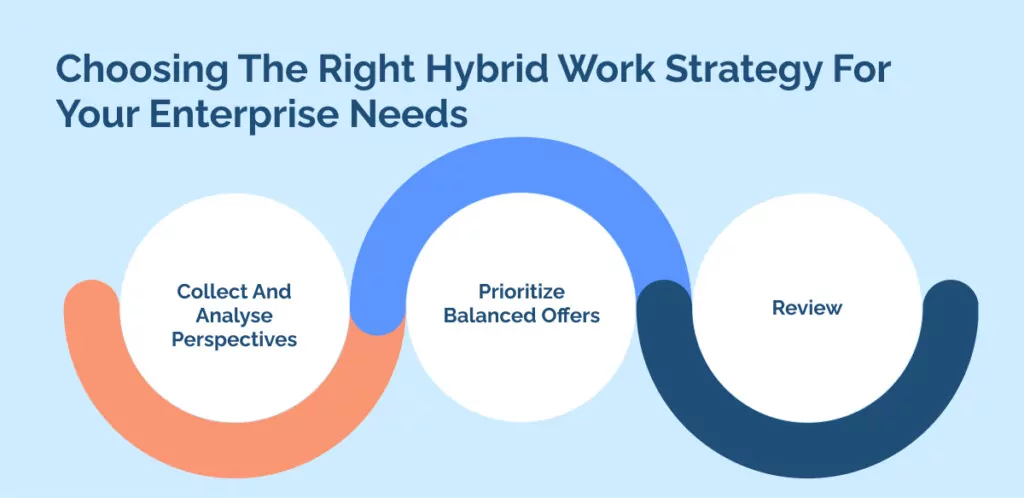
Generally speaking, most employees prefer to work from home, and most companies prefer staff to work in the office space. This tension creates a complex challenge for organizations today when they decide who is allowed to engage in hybrid working.
The best way to navigate this complexity fairly is to separate the issues involving culture, productivity, and staffing into three solutions that address all three. The first solution is to collect and analyze the different perspectives to see the value in each:-
1. Collect And Analyse Perspectives
You must collect and analyze different perspectives of staff in various roles to equip your organization with staff views on what the hybrid workplace strategy should look like and their desired position.
First, collect the data using simple staff surveys on hybrid policy. Secondly, visualize the data to help make the results accessible and easy to use to inform a decision. Thirdly, draw analytics from the data, emphasizing the tensions between different perspectives.
2. Prioritize Balanced Offers
There will always be some aggrieved parties when you decide who can work from home and who can’t. The best way to reduce this dissatisfaction is to try to please each stakeholder as much as possible by spreading the distribution of remote work among the most significant amount of staff.
3. Review
Despite the necessity for hybrid strategies, the marketplace is volatile, particularly after the economic aftermath of the global pandemic. Organizations today must regularly review hybrid working policies to ensure they still fit with employee and organization needs.
It is challenging to balance the needs of employees with the organization’s needs. But following the above steps can lead to greater satisfaction from both sides. But which hybrid work strategies are the most effective today?
4 Tried & Tested Hybrid Work Strategies To Implement In 2022
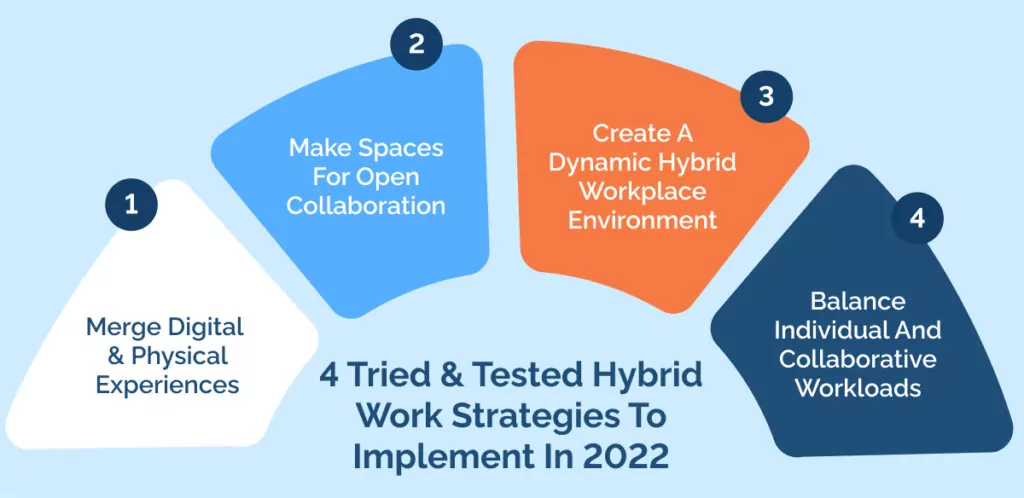
According to Harvard Business Review, 50% of companies plan to transition to a hybrid working model. But how can you choose the best hybrid working strategy for your company? You must begin with merging the physical and digital experiences into ‘phygital’ experiences.
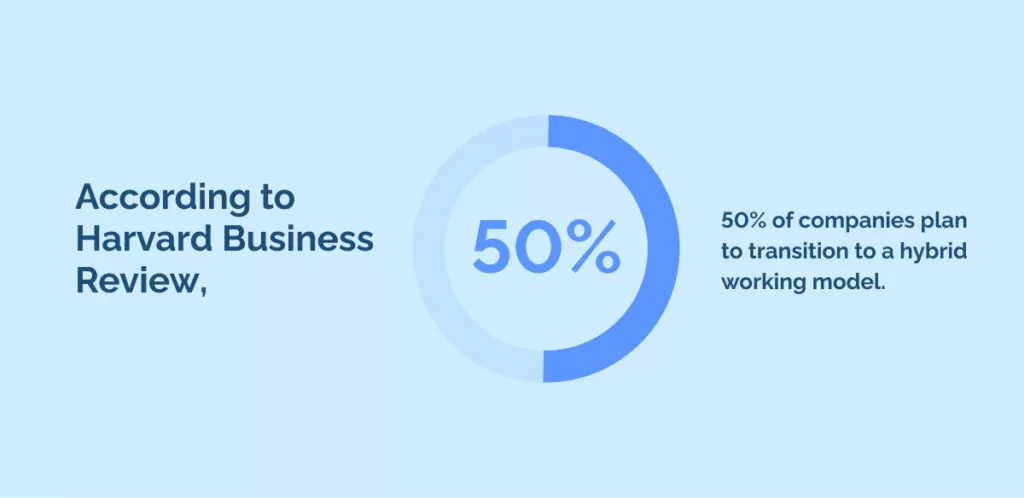
Merge Digital & Physical Experiences
Because of the disconnect in staff communication between staff at the office and home, frustration can cause reduced employee engagement from one or both sides. The solution to this issue is to engage in phygital environments emphasizing ease of use, equity of access, and total engagement.
There are many examples of how to merge the physical and digital to enhance communication:-
- Keep the long table meeting room format, but use laptops on rolling trollies to make staff feel like they each have a physical place at the meeting room table to adapt any office space into a hybrid workplace.
- Additional speakers and more appropriate lighting characterize the hybrid workplace to enhance the visual experience for employees’ webcams and extra microphones.
These changes can close the gap between the office and home work environment, enhancing employee communication and boosting performance.
Make Spaces For Open Collaboration
The hybrid workplace benefits from collaboration, so organizations need to adapt workplaces to promote working between employees. Some offices are still in traditional configurations, but the open office space promotes far more collaboration and communication. Movable physical boundaries mean fewer communication barriers that can stop employees from expressing their creativity and collaborative project ideas.
Agile approaches to collaborative spaces include:-
- Open spaces for quick stand-up meetings to share persistent content need flexible furniture and accessible technology.
- Private spaces are also needed for staff to focus on individual project work. Enclosed, sound-proof pods, panels, and moveable screens make it clear that an employee is engaged and unable to communicate with others.
Splitting spaces into clearly marked areas for collaborative or individual work leads to increased employee productivity as they can focus on the type of work they are doing more effectively.
Create A Dynamic Hybrid Workplace Environment
Business is constantly pushing the restraints of office buildings. This disconnect between infrastructure and business needs is because office spaces cannot keep up with the ever-increasing pace of technological disruption.
While all meetings in the past were conducted in person, needing enclosed meeting rooms, video calls are now the most popular and convenient way to communicate. This disruption needs infrastructure changes to get the best out of the new technology.
The way that the hybrid workplace strategy accommodates remote employees leads to companies reassessing and reducing the amount of real estate they need. However, the question is how many employees an office space requires. Answering this question helps an organization choose the right hybrid workplace strategy before committing to a radically new one without considering the drawbacks of most staff working from home.
Office spaces can be reduced in size and optimized for shifting purposes over the day. A single office area can become individual workstations in the morning, a café in the afternoon, and an open plan communal area that adapts for large or small groups after lunch.
Balance Individual And Collaborative Workloads
One of the benefits of collaboration sessions is that companies can assign workloads efficiently. Many remote employees enjoy sharing workloads with co-workers based in the office. However, Steelcase hybrid workplace specialists’ research suggests that employees show increased productivity when given home-working privacy.
This evidence shows that balancing collaborative and private spaces for office and remote workers is essential to ensure a balanced and flexible workload to optimize productivity. Gensler reports that 46% of the US workforce would prefer an open environment, yet 47% would opt for a private setting, showing this tension of preferences and the need to meet both needs.
The key to providing the right hybrid workplace strategy is to ask employees what they need and work toward this using internal and external research to justify investment in new hybrid workplaces.
What Are The Challenges Of Hybrid Work?
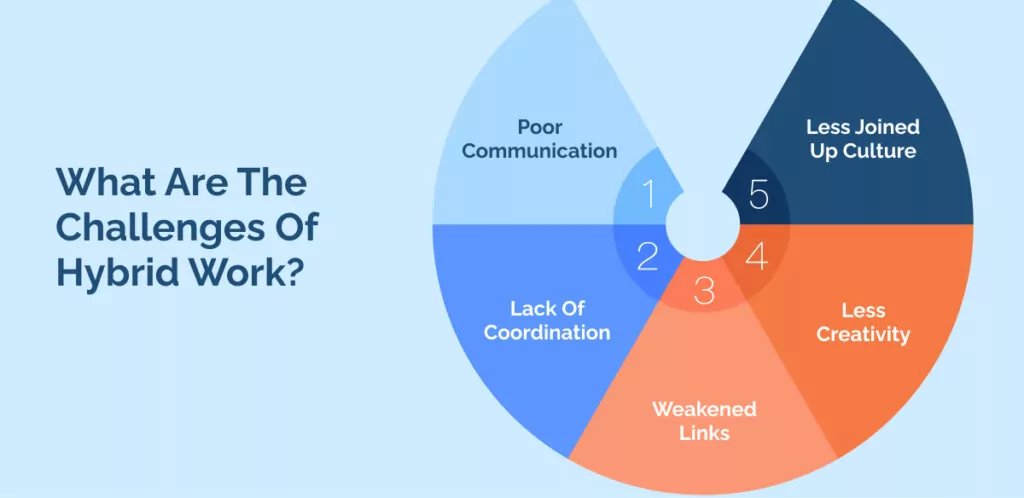
Despite the advantages of the hybrid workforce, there are many challenges. The first of these challenges is communication between staff.
Poor Communication
Technology creates communication solutions but often takes away the 1:1 human element of interactions. Many people face issues including language differences, level of authority, and other forms of power, which can reduce communication effectiveness across technology. Non-verbal communication is essential, and video conferencing reduces this.
Lack Of Coordination
Due to the differences in communication between remote and on-site workers, gaps can appear, which cause small but significant boundaries between these two worker groups. On-site employees may make minor decisions during exchanges outside of video calls due to the time required to set up a meeting for every decision. As these decisions continue to happen outside of video calls, when the remote employee attends the office, they will not be aware of the progress of a project, leading to inefficiency and frustration.
Weakened Links
It is not just professional links that are lost or weakened as part of the split between remote and on-site employees. Social links form a large part of the cohesion between individuals within teams. The non-professional interactions lost to remote work, such as shared experiences like birthday party lunches or shared jokes, weaken the links that strengthen bonds and raise morale.
Less Creativity
Two forms of creativity can be reduced or lost to hybrid work. One is collective creativity, as people can no longer meet up to brainstorm several ideas and discuss which ones work best. Individual creativity is the second type of creativity in danger due to hybrid work. Many employees need social interactions to inspire their private creative thoughts when alone. Employees who work from home alone all day may be less inspired due to the lack of social stimulation.
Less Joined Up Culture
Strong company culture is more challenging to develop and maintain when employees engage in virtual work as they are not working together face-to-face as often within a new hybrid world. Job satisfaction can be affected by not feeling a sense of organizational culture and reduced performance when working under a hybrid model.
However, there are solutions to all of these challenges.
How To Overcome Challenges With A Hybrid Working Model
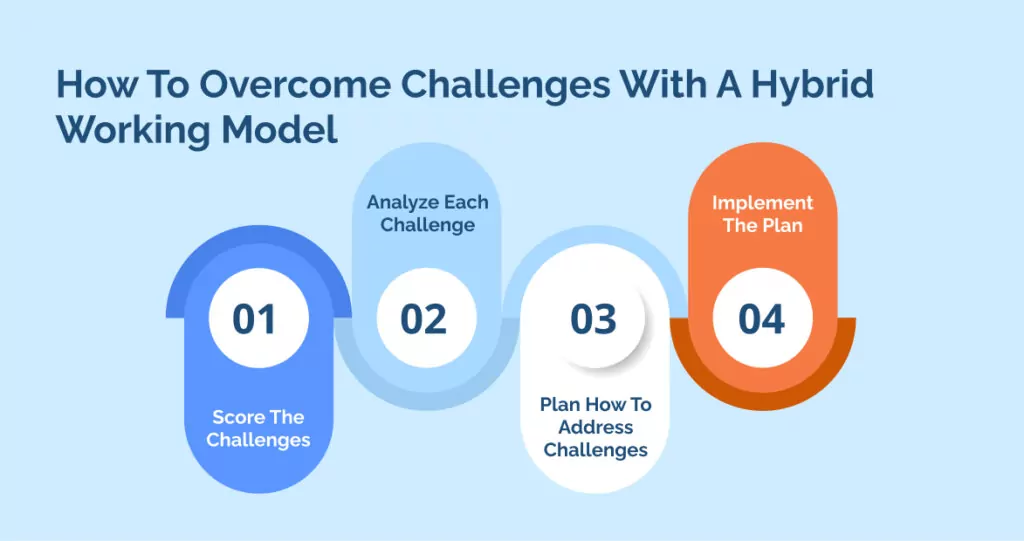
Every challenge has a solution, and the hybrid working model has pros and cons. There are ways to categorize these challenges and solutions into five groups, the first of which is scoring.
Score The Challenges
- Using the above hybrid work model challenges, score your organization’s progress out of 10.
Analyze Each Challenge
- Single out the hybrid work model challenge with the lowest score to focus on it.
- Discover why this is the weakest area by asking questions.
- If the weakest point is culture, do you need to increase the on-site days? Or are daily catch-up sessions needed, allowing teams to chat about non-work-related topics to strengthen relationships via increased social interaction?
- If connections are lacking, regularly schedule team-building activities throughout the year.
- Do this process for each challenge, from weakest to strongest, until you are ready to plan to get each challenge to the perfect score.
Plan How To Address Challenges
- To support employee wellbeing, prioritizing more flexible hours for working mothers. This respect for employee preferences often leads to a boost in employee productivity.
- Establish obstacles to achieving this aim and what you can do to overcome them.
- Starting with the lowest-scoring hybrid work models challenge, make three action points to improve it. Repeat this activity for each challenge.
Implement The Plan
- Design a timeline including clear milestones for implementing each point on the plan.
- Decide who will discuss and review the plan when they implement it.
- Define details of the key metrics, whether you plan to use surveys, feedback groups, or 1:1 feedback meetings.
- Set the period at which the plan will be reviewed and decide who is involved in the review process.
Following this process helps to record all challenges and make them clear and easier to resolve. Ensure regular review and repeat steps to adjust and improve to ensure success.
These processes help with the present challenges of remote working, but how will the future of work look?
Futureproofing Hybrid Work
When considering the hybrid future of work, it is easy to fall into the trap of focusing on technology adoption. Technology is important, but it is also essential to consider how organizations design spaces to fit the technology.
Are more lightweight laptops needed with lightweight trollies to allow remote staff to feel they have a place at the physical meeting table? Are moveable screens available for the staff? Are there enough sound-proof pods for people to use, and are they located in the most accessible area? These questions help ensure that the company optimizes investments in the right ways.
The balance will also become critical with increasing demands on staff due to market volatility and technological disruption. Quiet spaces are equally as crucial as collaborative spaces as different types of work require different levels of group or individual work.
Similarly, future organizations will need to increase focus and investment in employee well-being and satisfaction as employees. It is helpful for some employees to work remotely. Still, communication is very different, and it becomes more challenging for team managers and peers to see that a colleague’s well-being is deteriorating. Constant team meetings can also be stressful, so leaders must prioritize well-being.
The Great Renegotiation is the next phase of the business world following The Great Resignation. This event will lead to organizations having no choice but to listen to the demands of the entire workforce, who will leave their organization if their needs are unmet. While generally speaking, many employees prefer remote work and employers prefer in-person work, the new world of work may see more employee power to have their work environment needs to be met than ever before, enhancing the employee experience.
The Hybrid Model Holds Solutions For Every Challenge
Companies must regularly review hybrid strategies to meet changing employee and market needs. The priority is to include as many staff as possible in the decisions by capturing employee preferences as often as possible and in the most meaningful way.
A hybrid workplace strategy can be complex, but it is helpful to remember that there are solutions to every problem created by a hybrid workforce. The future will become more flexible and hybridized. So organizations must try to work hybrid workplaces and remote work into their policies or face dissatisfaction and possible departures amongst staff.
WalkMe Team
WalkMe spearheaded the Digital Adoption Platform (DAP) for associations to use the maximum capacity of their advanced resources. Utilizing man-made consciousness, AI, and context-oriented direction, WalkMe adds a powerful UI layer to raise the computerized proficiency, everything being equal.



